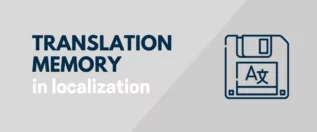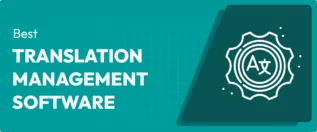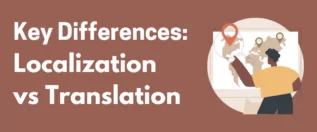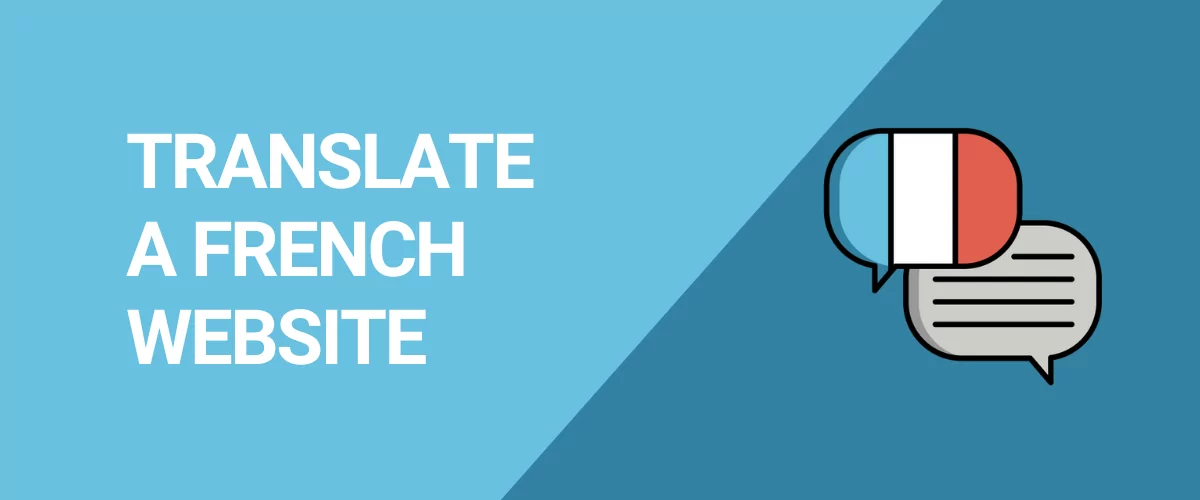
In this post
Bonjour! Tu vas bein? Can’t figure out how to translate a French website to English? Don’t sweat it – we have your back.
I agree translating a WordPress website is often confusing. And if you don’t do it right, you might do more harm than good.
How?
Think of literal translations that don’t make sense to your target audience—or having to fight complex translation tools that make you want to pull your hair out.
Also, you might do your best tinkering with lots of tools only to end up with a website with half-done translations.
I mean. Unlike simple static websites, a WordPress website has so many moving parts.
For instance, how do you translate dynamic content that your theme or plugins generate on the fly?
How do you rephrase WooCommerce products and emails, for example? How about translating URLs or SEO elements added by an SEO plugin?
Translating a WordPress website can drive anyone crazy, even experienced developers.
Still, you want to translate your French website to English because it’s crucial to the success of your business.
But how do you do it properly with so many moving parts?
Ladies and gents, I would love to call your attention to a remarkable translation tool that will rock your world.
Taking center stage is TranslatePress, the subject of today’s review.
In the upcoming sections, I will show you exactly how to translate your French website into English. We will translate text, images, plugins, themes, and everything else.
By the end, you should handle French website translation like a boss.
Deal? Good.
Let’s get down to business.
Benefits of Translating a French Website to English
You’re ready to translate your website from French to English, but did you know you stand to enjoy some sweet benefits? I bet you didn’t, so here we go.
It’s a Numbers Game
Humor me this. Which is the most spoken language in the world? Perhaps that’s too easy. Here’s another one. Which is the most studied foreign language in the world?
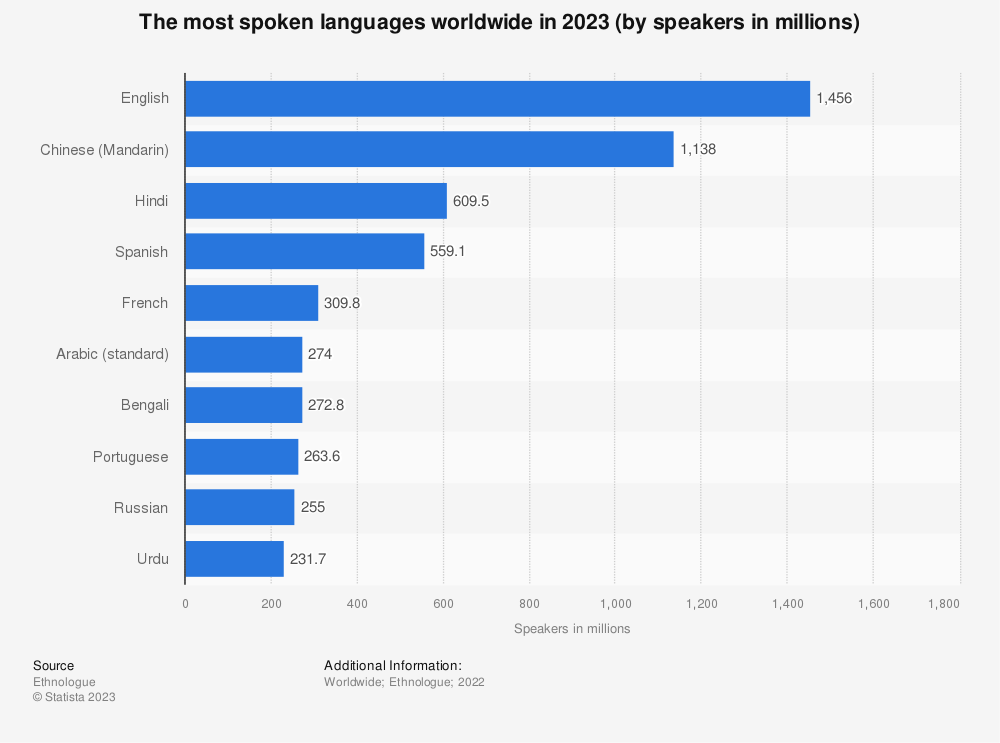
Yep, it’s English, with more than 1.4 billion speakers.
French? Well, not so much, with about 310 million speakers globally.
Do you know what that means?
It means there is a good chance there are plenty of English speakers in your target audience. It’s a no-brainer, no matter how you look at it.
And do you know what else? A survey of 8,709 consumers in 29 countries by CSA Research found that 65% of online shoppers prefer content in their language, even if it’s poor quality 😲
On top of that, 76% prefer to buy products with information in their native language. Wait, it gets better. From the same report, 40% of the respondents said they would never buy from websites in other languages.
You very well know what this means as a marketer or website owner. If your analytics reports show you’re receiving many hits from English-speaking locales, the time is ripe to translate your French website.
With over 1.4 billion speakers, you can see how you risk missing out on many golden opportunities if you don’t offer an English version of your site.
In other words, you’re leaving a lot of revenue on the table.
You’re here because you’re looking to enter English-speaking markets. Right? Translating your French website to English gives you an advantage over your rivals.
If it’s an entirely new market, you have the head start to set the quality and standards your competition must beat to outshine your brand.
SEO Advantages

You may rank high on Google for French keywords, and that’s good. But how are you fairing when it comes to English keywords?
Yeah, that’s right – you won’t rank for English keywords for the most obvious reason; you don’t have English content.
Another thing, some French keywords might have a high keyword difficulty (KD) compared to their English counterparts.
Look, you already have French content down pat. Translating the same content to English helps Google rank your website for English keywords – all without creating fresh content.
In other words, Google ranks both versions of your website, which – as you’d expect – gives your SEO rankings a much-needed boost. As a result, you receive more traffic to your website.
Seeing is believing, right?
Kinsta noticed an 18% increase in organic traffic when they translated their website to 10 languages. Neil Patel boosted search traffic by 47% by translating his content into 82 languages. That guy is something else 🙂
People tend to search Google in their native languages. English-speaking searchers will hardly find your French content, even if they are looking for the products or services you sell.
Does that make sense?
And if English-speaking searchers find your website by chance, they will bounce immediately because they can’t understand your French content, which leads to high exit rates and lower SEO rankings.
A poor experience doesn’t reflect well on your brand image, which leads to our next point.
Brand Visibility

Think of global companies such as Apple or Samsung. How would such companies reach a global audience if they offered websites in one language?
And how would you perceive either if their websites were in one language only? It wouldn’t reflect well on their brand images, now would it?
An English version of your French website allows you to reach more people, which translates to more brand visibility.
Since English visitors can understand your now-translated content, it reflects well on your brand image. In other words, it shows you care about your customers.
The translated content is also easy to share on social media, boosting brand awareness. It is a chance to earn brand mentions and social signals, which tells Google you’re the real deal.
Trust and Credibility

Remember the stats we dropped earlier? About the 40% of online shoppers who would never buy from a website that wasn’t in their native language? I bet you do.
Now, if an English-speaking person lands on your French website, they are most likely to turn and run. Why? They wouldn’t enjoy the user experience.
And we all know a poor user experience doesn’t instill a feeling of trust. As a result, you lose credibility points left, right, and center.
As I have said, offering your English-speaking visitors a version of your site in their language shows you care about their needs.
What better way is there to boost your credibility as a reputable brand? I can’t think of anything. You? Would you trust a website you don’t understand? Would you even hang around long enough to buy anything?
Do you want to boost trust and credibility among your non-French-speaking visitors? Give them what they want – a website they can understand without opening Google Translate.
We live in a global multilingual world, so assuming your audience consists of only French speakers (yes, even if you’re in France) is akin to shooting yourself in the foot.
Now that you can tell translating your site from French to English has some lovely benefits (this is just the icing on the cake), let us see how TranslatePress helps.
How to Translate a French Website to English with TranslatePress
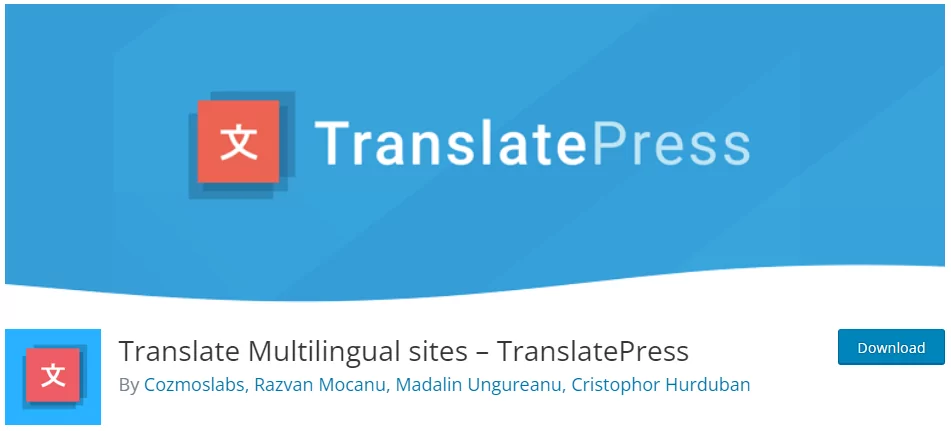
In the following section, you will join me in installing and configuring TranslatePress to translate your site from French to English.
I promise it’s as easy as pie anybody can do it. You don’t need special coding skills or tech superpowers since TranslatePress lets you translate your website visually. Also, I won’t skip a step and will be with you all the way 🙂
Ready for the fun part? Great, let’s get to it already.
How to Install TranslatePress
The main TranslatePress plugin is 100% free, meaning you can install it inside your WordPress admin dashboard.
Navigate to Plugins → Add New.
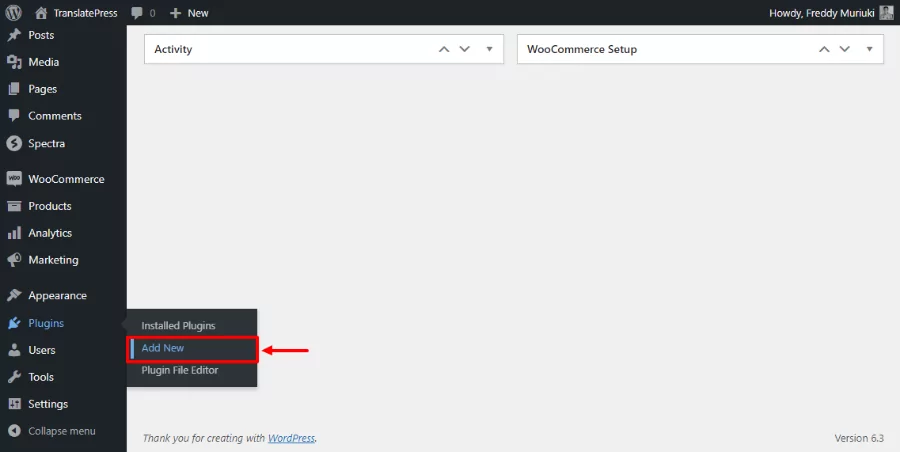
Next, enter “TranslatePress” in the keyword search box and click the Install Now button.
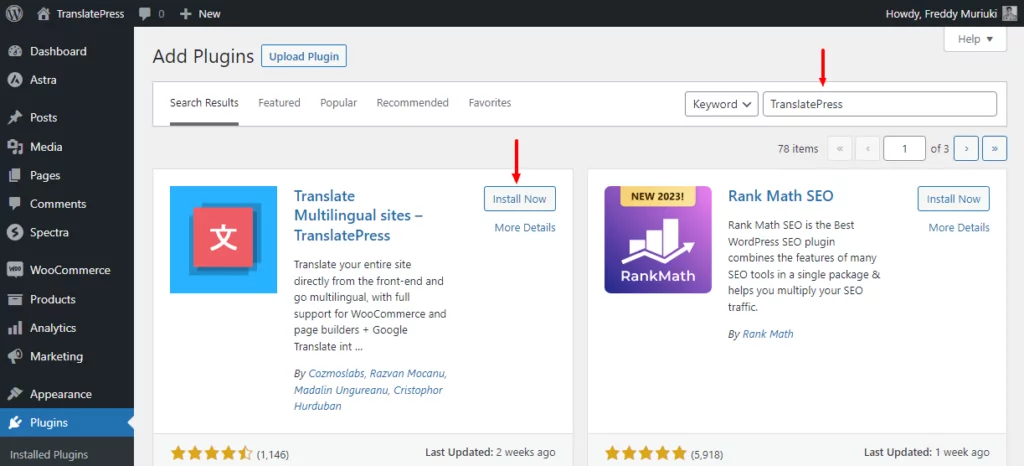
After that, Activate the plugin.
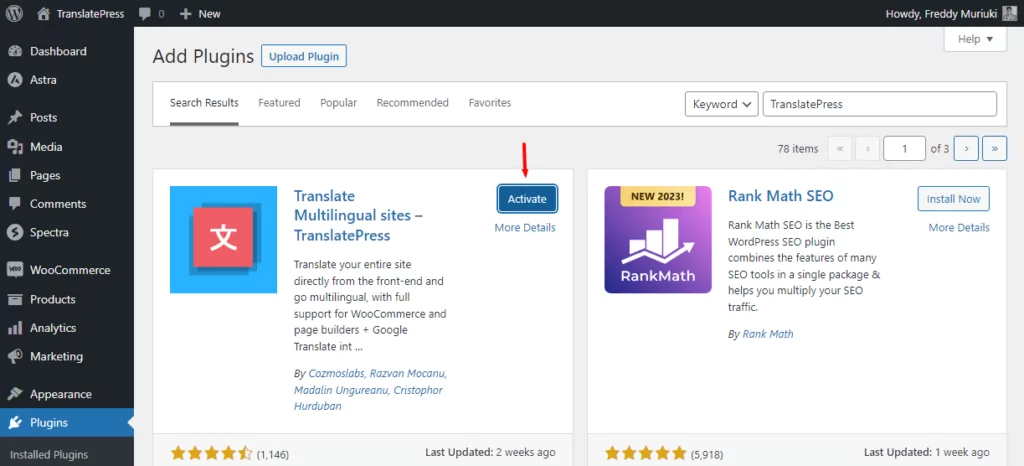
Next, click Allow & Continue because you rock.
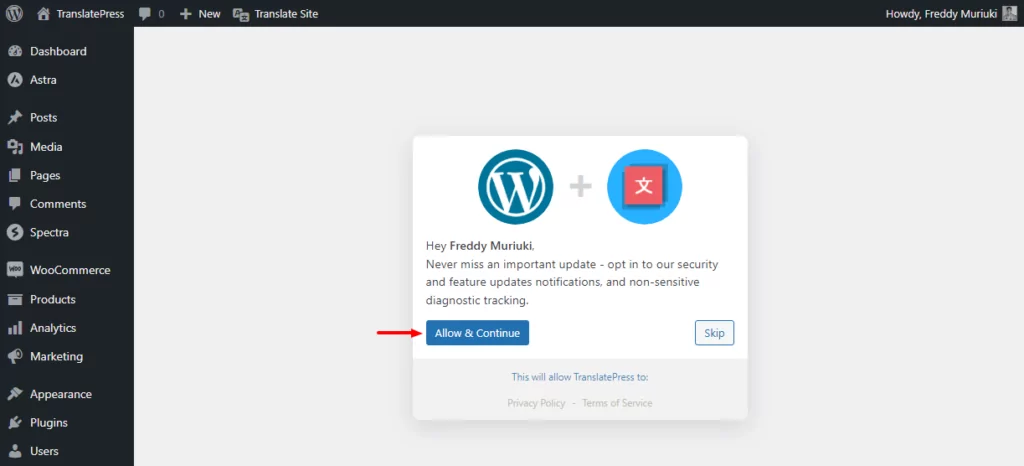
You’re doing just fine.
After that, let us set up the default site language, i.e., French, and the translation languages, i.e., English. Go ahead and choose French under the Default Language drop-down. Then add English under the All Languages section, as shown below.
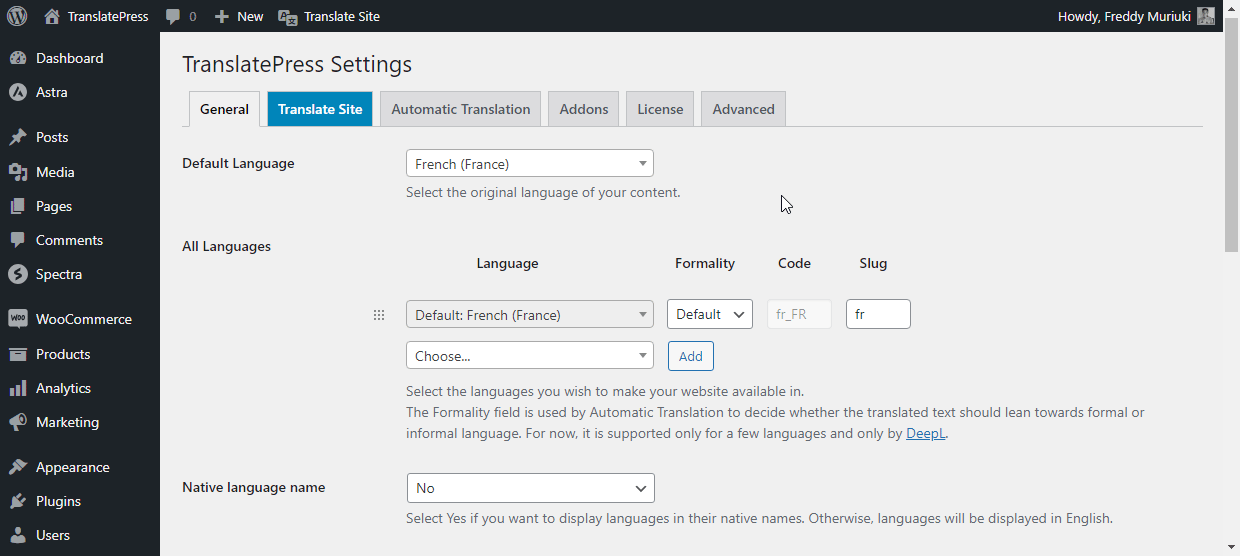
Always remember to save your changes. 👍
Pro Tip: TranslatePress Business lets you add multiple translation languages, e.g., English UK, English South Africa, English Australia, et cetera. You also have many more features, as you will learn later.
⛔ Stop: Don’t rush to check your website yet. At this point, we have just installed TranslatePress and added our preferred languages. Now you are ready to translate your website automatically or manually.
In the following section, I will show you how to translate your website automatically using Google Translate. Later, we will do it manually.
How to Translate French Website to English Automatically
Are you having fun yet? No? Okay, this next section should get you going. TranslatePress supports automatic translations via Google Translate and DeepL.
The free version of TranslatePress offers Google Translate, but you’ll need to upgrade to a paid version to use DeepL.
Automatic translation helps you to save time and cut costs. It’s faster and cheaper than hiring professional translation services.
Tip: You can translate your French site for free if you don’t exhaust the limits of Google Translate’s free tier.
The free tier lets you translate 500,000 characters per month. That’s about 100,000 words per month. If you exhaust the limits of the free plan, you’ll pay $20 per 1,000,000 characters ( ~ 200,000 words).
Since we’re working with the base version of TranslatePress for this section, we will use Google Translate for our automatic translations.
First, we need to generate a Google Translate API key.
Follow the guide linked above or watch the video below.
Note: If it’s your first time, Google will hook you up with $300 worth of credits. Also, you won’t be charged if you run out of credits. You are only charged if you upgrade to a paid plan.
Oh, by the way, here’s a screengrab of the test site I’m working with.
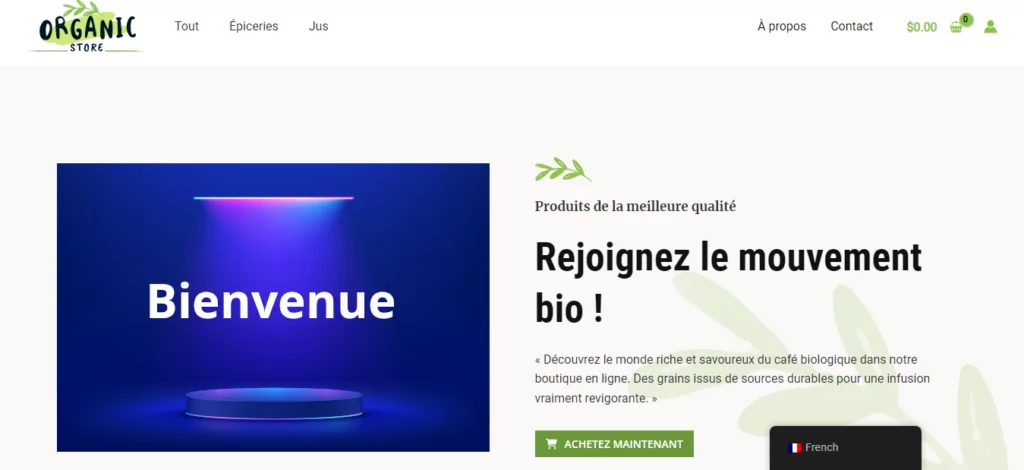
After generating your Google Translate API key, head to your TranslatePress settings page and click Automatic Translation, as shown below.
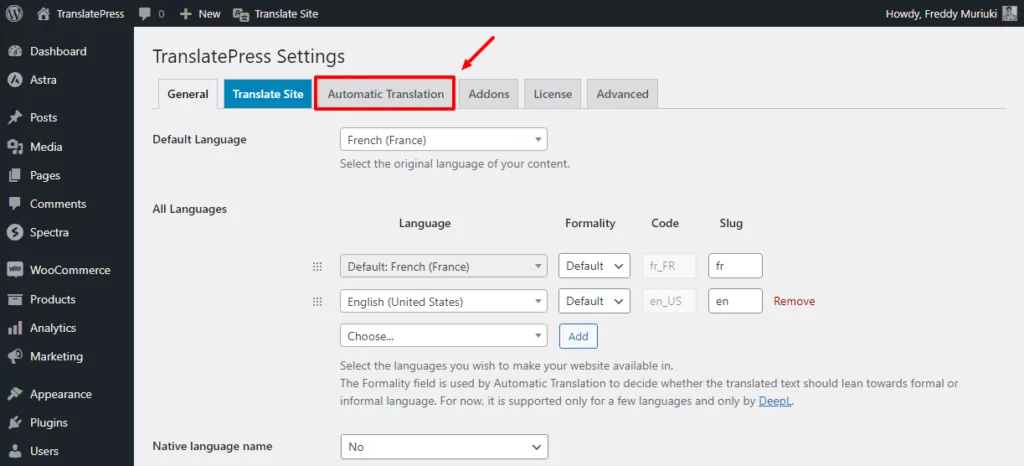
After that, enable automatic translation, enter your Google Translate API key, and save your changes.
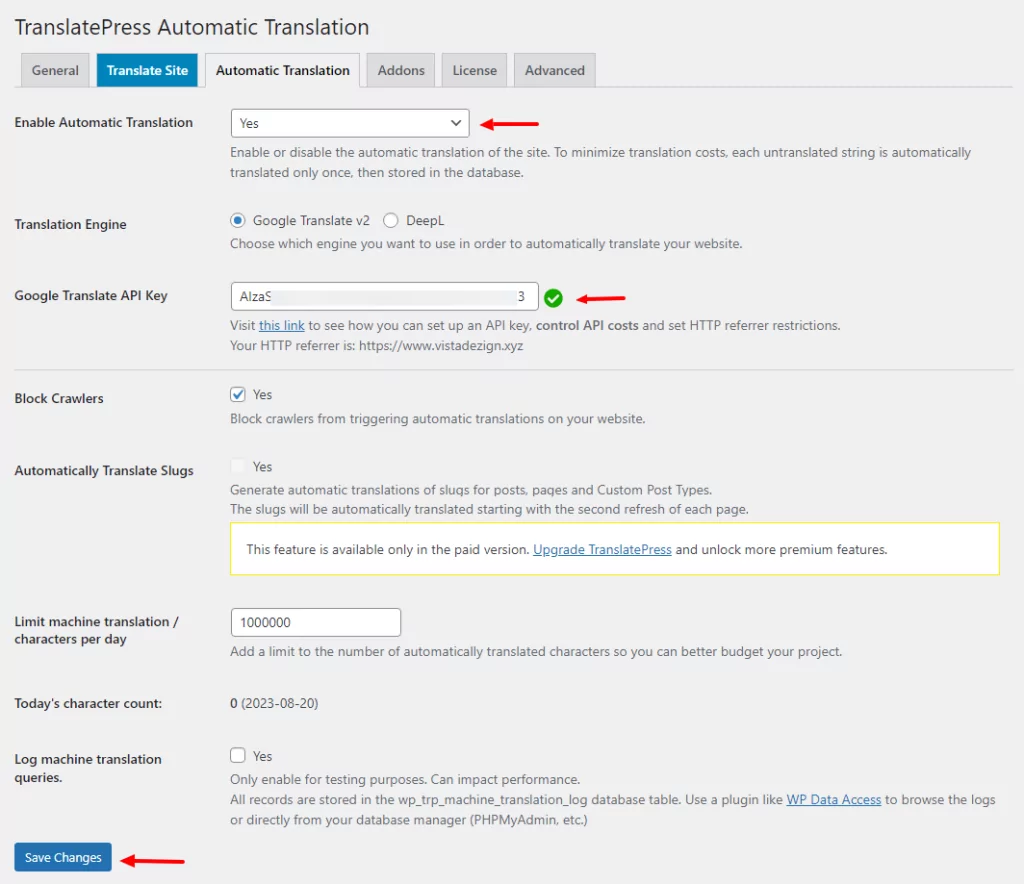
And that’s it. TranslatePress will take over from there, translating your website automatically in the background. All of your pages will be translated upon the first visit in the English language and all the translations will be stored in your own database.
Now, if we check our test site, we see the English version.
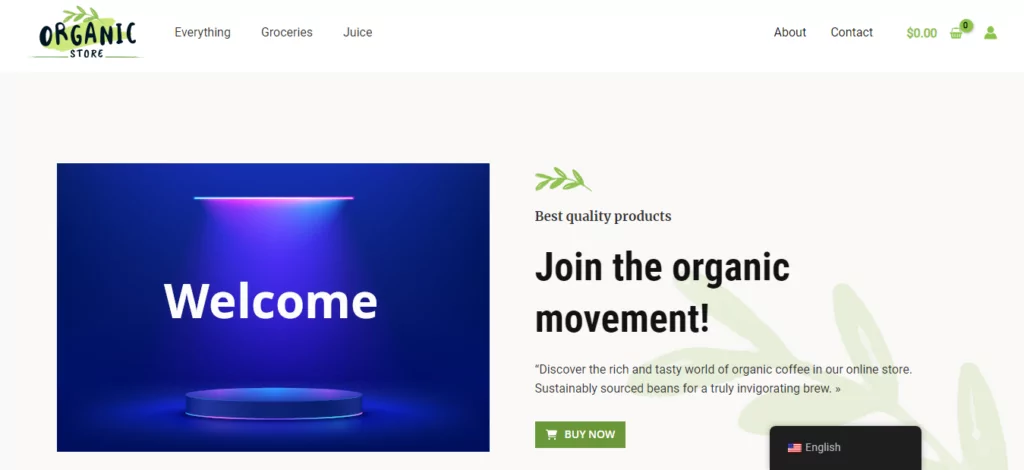
That wasn’t so hard, now was it?
Note: I had already translated the image on my test website using TranslatePress (more about this in a minute).
At this point, you have an English version of your French website.
The TranslatePress plugin uses Google Translate AI to power automatic translations. As you’d expect, a machine can easily miss the nuances of human language.
For example, Google Translate might miss street lingo and other phrases common in French but lack equivalent counterparts in English.
Also, you might not like how Google translates some words.
What to do?
Enter manual translation, and you save the day.
How to Translate French Website to English Manually
This is where TranslatePress truly shines. After enabling automatic translations, you can fine-tune translations manually to edit/remove anything that doesn’t sit well with you. All in all, you end up with polished translations.
TranslatePress lets you translate your website in a visual editor on the front end. That way, you can see the translations in real-time like your readers would.
How?
Open the page you’d like to Translate and click Translate Site on the WordPress admin bar, as shown below.
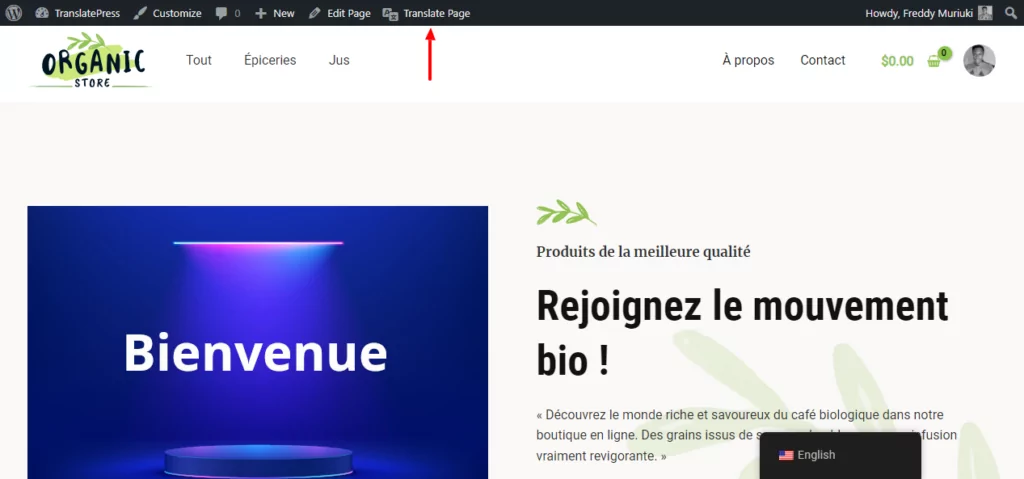
After that, set the language to English so you can see the translation changes directly on the page.
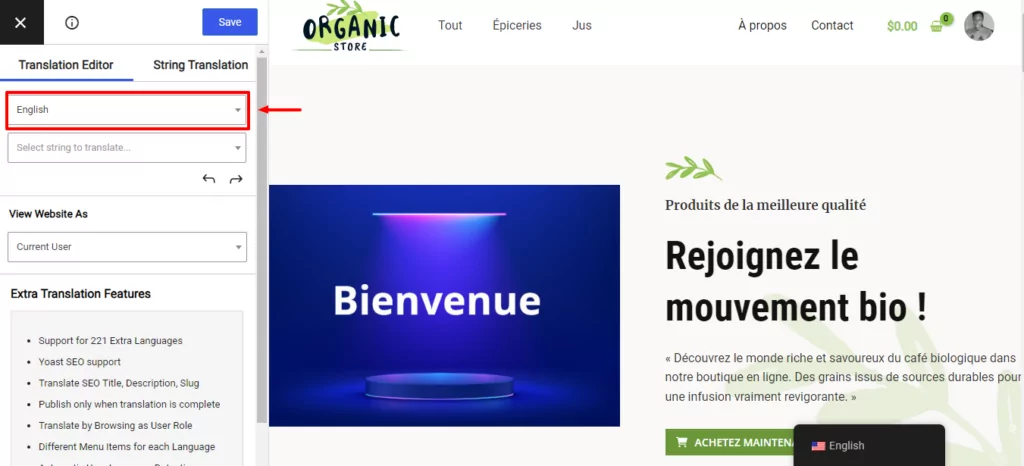
Next, choose the text you wish to translate by clicking the pencil icon. After that, add your English translation, and click the Save button, as illustrated in the GIF below.
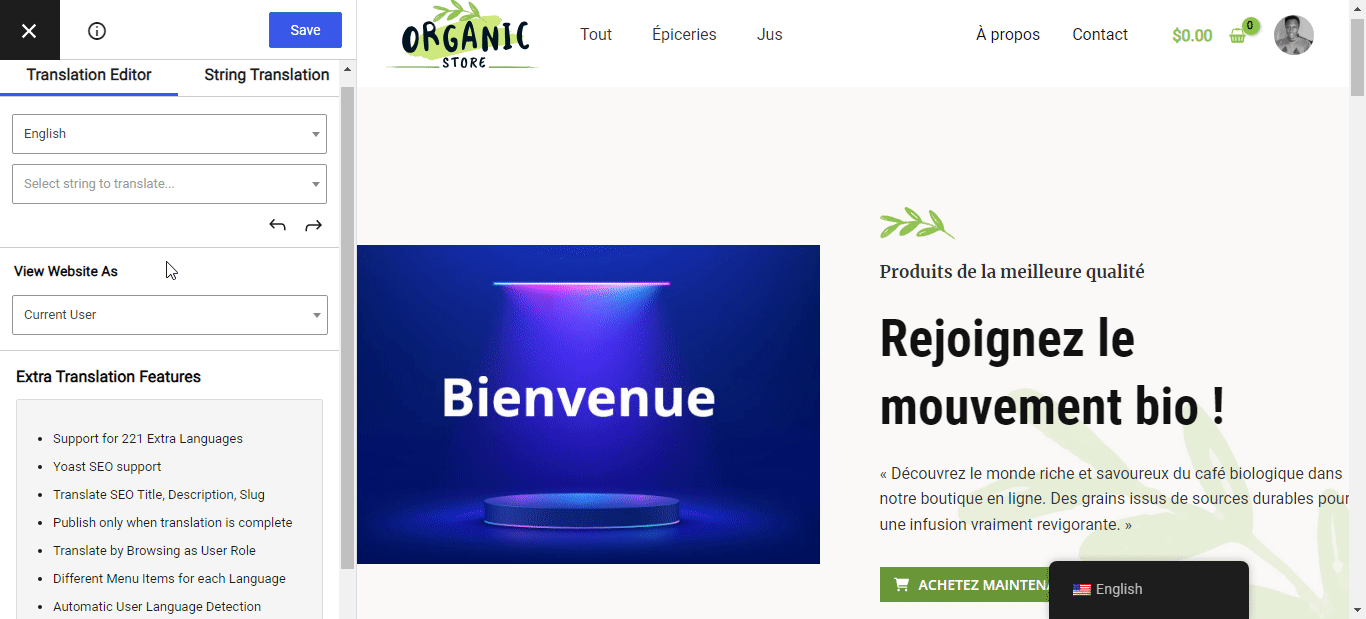
See? I told you it was easy. You can translate all content on your website similarly. That includes menu items.
But that’s just text. How do you translate images?
How to Translate Images From French to English
Often, you need to change images when you switch from French to English. This is especially true if the image contains text that needs to change when the page changes.
We have a helpful guide on translating images in WordPress, so I will keep this part short. Still, here are some use cases where image translation comes in handy:
- Adding an image or logo with text that needs to change when you switch the language;
- An ebook cover that needs to change the title from French to English and vice-versa;
- Multilingual sliders that contain several images with text that needs to change when you switch from French to English;
- Translating WooCommerce product images.
TranslatePress makes translating images extremely easy. You can even translate the title and alt text. Here’s how to do it.
First, you need two images; one with French text and one with English text. Use the same image with similar dimensions, but you can be creative. Upload the pictures to your WordPress media library.
Inside the TranslatePress visual editor, click the image you wish to translate and replace it, as highlighted below.
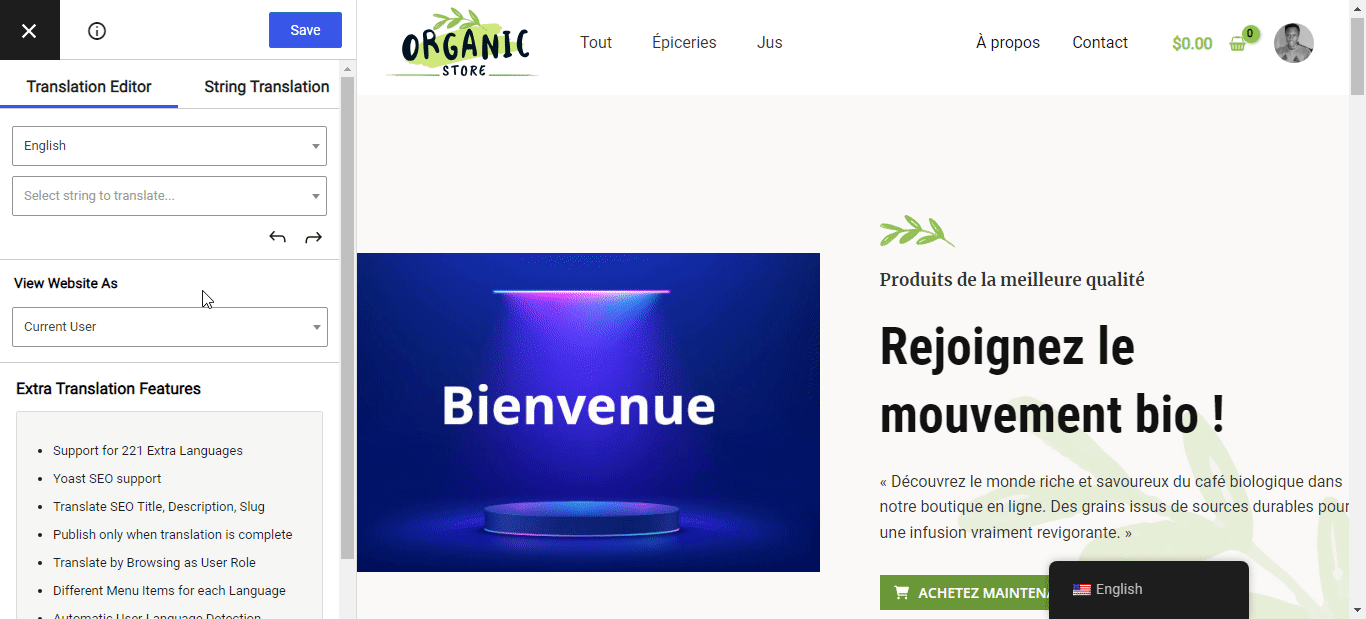
As a result, the image will change whenever you switch from French to English. You can replace all media types similarly.
So far, so good. I hope you’re learning something today. And to think that all these features are available in the gratis version of TranslatePress.
But what if you need more? What if you need to translate dynamic content, e.g., strings added by your theme, plugins, and menus? What about WooCommerce emails?
If that’s the case, the upcoming sections will be helpful.
Let’s move on and learn how to translate strings from plugins.
How to Translate Dynamic Strings from Plugins & Themes
Plugins are an integral part of any WordPress website. Without plugins, website owners would have to hard-code every feature they need into the website. As you’d imagine, this is not feasible.
As much as plugins are helpful, they present a unique challenge when translating a website from French to English. This is especially true if you’re dealing with plugins that aren’t translation ready.
Plugins usually generate what is commonly known as dynamic strings. This type of content is not set in stone. It’s not like the static text content in your article.
Dynamic strings (or gettext strings) change depending on multiple factors, including user input and other variables.
For example, the popular e-commerce plugin WooCommerce does a lot of heavy lifting in the background to create the online store you see on your WordPress site.
In the process, it generates dynamic strings–or pieces of content that are impossible to type manually. They are generated on the fly. Thank God plugins such as WooCommece are translation-ready.
These dynamically generated elements can get in the way of things when it comes to translating your website.
Examples of dynamic content include:
- 404 page content;
- Next page;
- Previous page;
- Rated %s out of 5;
- Published by %s;
- Proudly powered by %s;
- No products in the cart;
- Continue shopping;
- Etc.
Phew – I tried to make that as beginner-friendly as possible. I hope it makes sense 🙂 To learn more, please check out translating dynamic strings in WordPress.
Not to worry. You can use TranslatePress to translate dynamic strings in any plugin or theme. This lets you offer an augmented multilingual experience on your site.
In the TranslatePress visual editor, you can view gettext strings active on any page, as shown below.
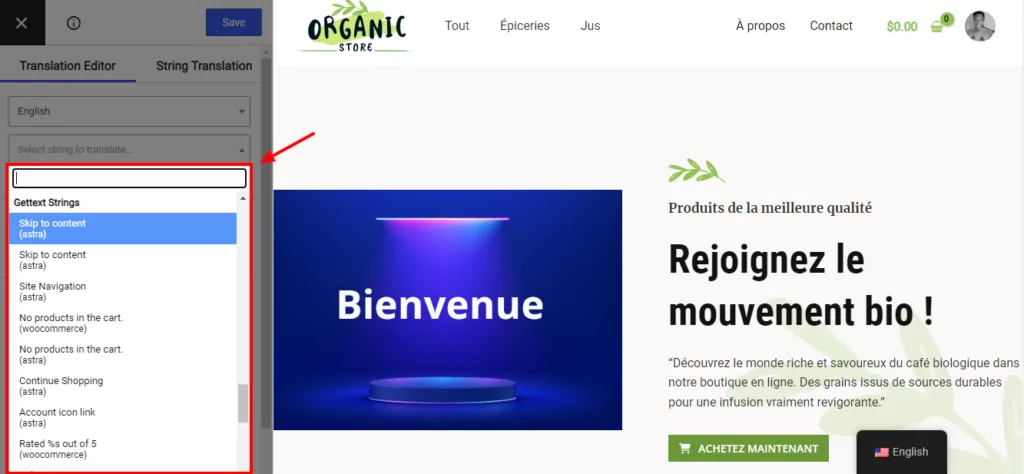
Click on any gettext string to provide a translation and save your changes.
If this is confusing, please check out the following guides.
- How to Translate WordPress Plugin in Any Language;
- How to Translate WordPress Theme – Full Theme Translation Guide.
With that done, let us mention a thing or two about translating WooCommerce emails.
How to Translate WooCommerce Emails
We can agree that the emails WooCommece sends you and your customers are super important. The emails let you stay on top of things and keep the customers in the loop.
WooCommerce emails for multilingual sites can get tricky since you must consider each user’s preferred language.
So, how does TranslatePress translate WooCommerce emails?
For emails that WooCommerce sends your customers, TranslatePress uses the language in which the user last visited your site.
If the website doesn’t require login before purchase, the plugin uses the language selected during checkout.
For emails that WooCommerce sends to the admin or shop manager, TranslatePress uses the language the user has set in their profile.
Check out how to translate WooCommerce emails manually to learn more.
How to Translate SEO Elements & URLs
SEO is a crucial part of any multilingual website. When done right, SEO can help you rank higher in SERPs and drive more traffic from the same content in different languages.
The same goes for your French-to-English translations. You can rank for French and English keywords. But how do you ensure you have the appropriate SEO elements for each language?
That’s simple. You use a plugin such as TranslatePress, which makes translating SEO titles, meta descriptions, and URLs super-duper easy.
Note, however, that translating SEO elements and URLs requires the pro version of TranslatePress.
Once you activate the paid version, click Addons and activate the SEO Pack addon.
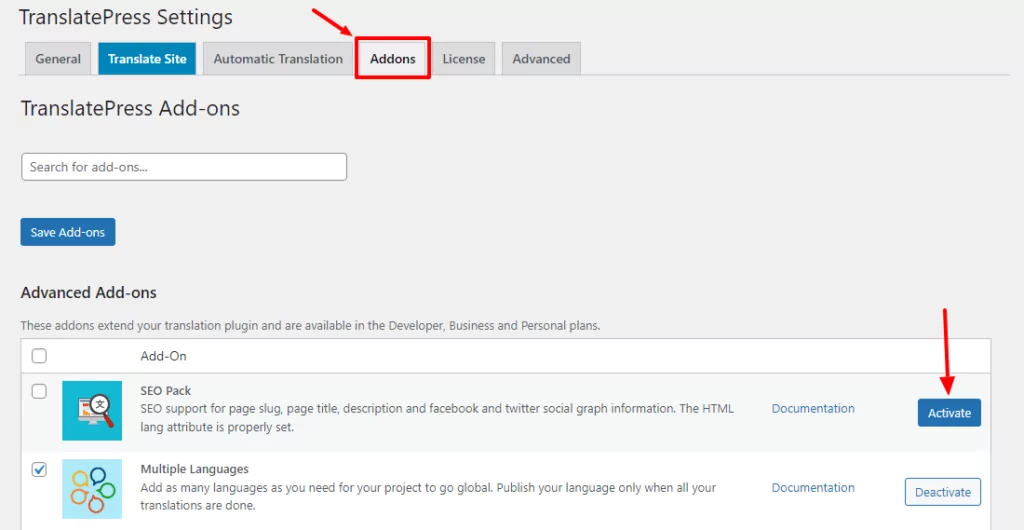
After that, open the post/page you’d like to translate in the TranslatePress visual editor. Next, click the drop-down menu to view and translate your meta information, as shown below.
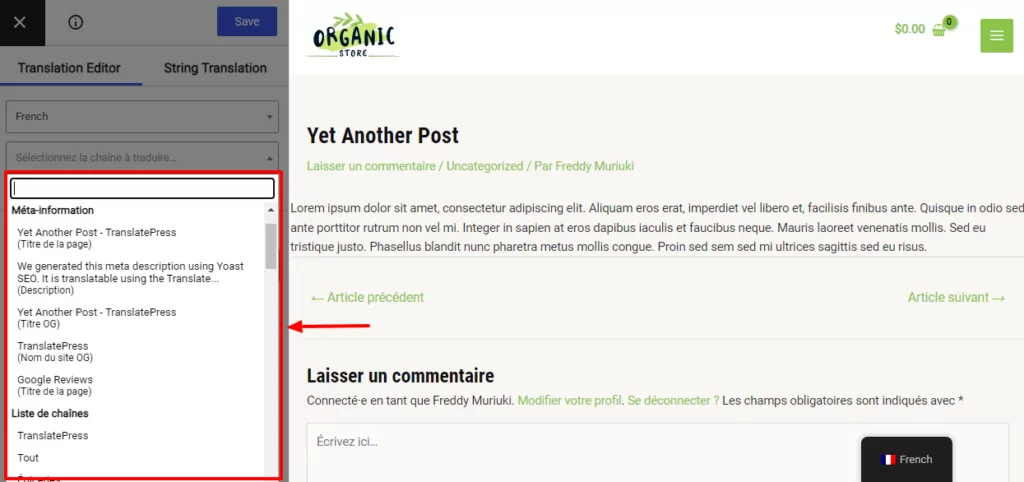
Click to translate the meta description you want and save the changes.
To translate URLs, select the slug you’d like to translate from the same drop-down menu.
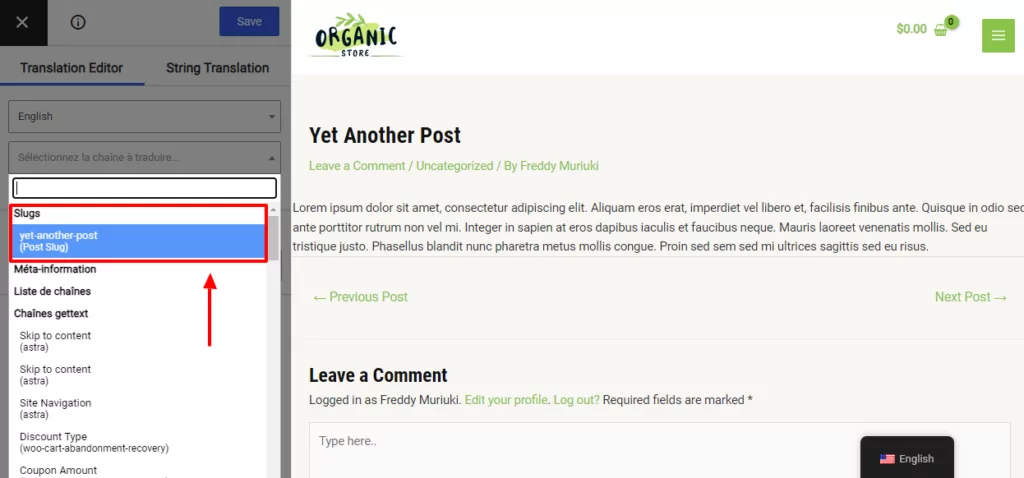
Edit the slug and save changes.
As can be seen, TranslatePress allows you to translate all content on your website visually without breaking a sweat.
Other TranslatePress Pro Features include:
- Full Yoast SEO support;
- Support for 221 extra languages;
- Translate SEO title, descriptions, and slug;
- Publish only when translation is complete;
- Translate by Browsing as User Role;
- Different Menu Items for each Language;
- Automatic User Language Detection;
- And more.
Finally, you can use the same process to translate your website from English to French.
TranslatePress Multilingual
Translating your website from French to English needn’t be challenging, especially with an easy tool such as TranslatePress in your toolbox.
What are your views? Let us know in the comments!
If you found this post helpful, please check out our YouTube channel, where we constantly upload short & easy-to-follow video tutorials. You can also follow us on Facebook and Twitter to be the first to know each time we post.
